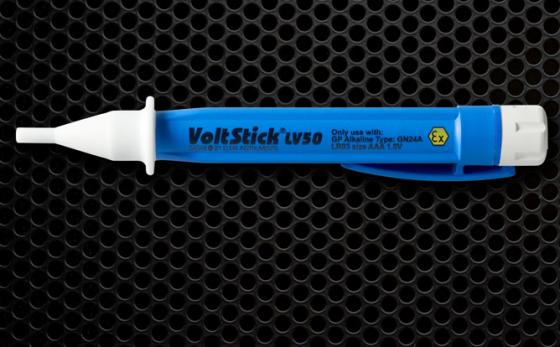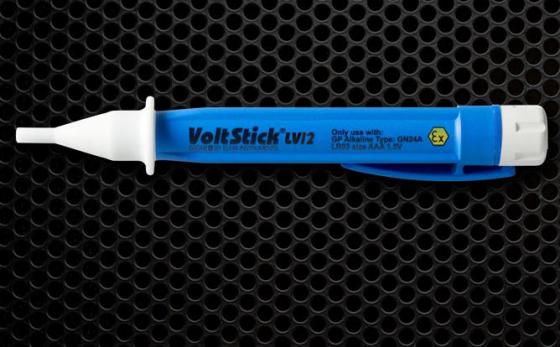Touch Potential Safety Thresholds
If you are responsible for protecting yourself or others against the effects of electric shock then you will probably be familiar with the term ‘Touch Potential Safety Threshold’.
But do you know what your Touch Safety Potential Threshold should be? Do you know who sets it? Do you know how it was calculated? And importantly did you know the Threshold you use can affect not only your Safety, but also your Productivity?

What is a safe voltage threshold, how is it calculated and who sets it?
The motivation for researching and writing this document came from exhibiting the Volt Stick LV50 at the World Gas Conference in Washington DC. Whilst there, we took the opportunity to talk with a number of safety managers from all across the world and soon discovered that companies such as National Grid, Southern Company Gas, Center Point Energy and many more were using very different safety guidelines.
What we had previously assumed to be a universal safety standard was actually not the same for everyone and sometimes different in parts of the same country; why would this be?
We needed to find out why engineers carrying out similar work were using very different Voltage Safety Thresholds. Why were some safety managers telling us that they used 50 Volts as a Safety Threshold and others suggesting 12 or 15 Volts?
When we asked them ‘Why?’, we were told ‘because we follow these guidelines and that’s what it states is safe...'.
Before we start, we should explain that as a company we manufacture a Non-Contact Voltage Detector which is widely used in the Utilities industry. The Volt Stick LV50 is an Intrinsically-Safe Non-Contact Voltage Detector that is used as a safety device to identify potentially dangerous stray voltages of 50Vac or more on metal pipework and metallic surfaces.
However, this feature isn't trying to sell you the Volt Stick LV50 or to tell you that 50 volts is the correct safety threshold; but we do hope to share information that enables you to ensure that you are using the right equipment and safety guidelines to keep yourself and your colleagues as safe as possible from electrical hazards!
In fact, as a result of writing this feature, we have been involved in developing a new 12v Volt Stick variant that is to be used by a major US gas utility provider, who decided that a 50v safety threshold wasn’t the right one for their engineers! Instead, they have chosen to use a 12v threshold and the Volt stick team have designed a brand new product for them to safely detect 12Vac which will help protect their work force.
But why did they decide on 12v and not 15v, 24v or 50v? What follows will explain how voltage thresholds are calculated and this will hopefully give you a better understanding of what you will need to consider when calculating your own Touch Potential Safety Threshold...
What is a Touch Potential Safety Threshold? (TPST)
If you are responsible for protecting yourself or others against the effects of electric shock, then you will probably be familiar with the term ‘Touch Potential Safety Threshold’ (or TPST). If you’re not familiar with this phrase, in simple terms, a ‘Touch Potential Safety Threshold’ is a Voltage Level that is regarded as ‘Safe’ to touch.
In a little more detail, it is the potential difference in voltage between two points. More so, a person could accidentally bridge the gap between those two points and an electrical current would flow through their body without causing them injury or death. Health and safety guidelines use this threshold to design safe working practices which will protect people from any hazards arising from the effects of electricity in the workplace. By following such guidelines and regulations, you would comply with the local law and, importantly, safeguard your workforce.
Why are there different TPSTs?
If a TPST is there to safeguard against fatal hazards in the work place, then why are there different Thresholds?
This is where it gets interesting. Whilst speaking to numerous industry safety managers at the trade show, it became clear that there were different safety thresholds being used by different companies, companies were doing very similar work; changing out meters, opening metal enclosures or working on pipe lines in excavations. So why would their engineers be using different safety thresholds?
We discovered companies using guidelines from at least 3 different official bodies; the UK’s Health and Safety Executive (HSE), the Occupational Safety and Health Association (OSHA) and the National Association of Corrosion Engineers (NACE).
Who are the different H&S bodies?
 • UK- HSE (Heath and Safety Executive) - is a UK Government agency responsible for the encouragement, regulation and enforcement of workplace health, safety and welfare and for the research into occupational risks in the UK.
• UK- HSE (Heath and Safety Executive) - is a UK Government agency responsible for the encouragement, regulation and enforcement of workplace health, safety and welfare and for the research into occupational risks in the UK.
In its Guidance Document HSG85, the HSE states a Safety Threshold of 50Vac.
 • US – OSHA (Occupational Safety & Health Association) – is part of the United States Department of Labor and is to ensure safe and healthful working conditions for workers by setting and enforcing standards and by providing training, outreach and assistance.
• US – OSHA (Occupational Safety & Health Association) – is part of the United States Department of Labor and is to ensure safe and healthful working conditions for workers by setting and enforcing standards and by providing training, outreach and assistance.
In it’s guidance 1910.269(I)(3)(i), The OSHA states in table R3 that anything up to 50Vac is a Safe Working Voltage.
• US – NESC (National Electrical Safety Code) – Is a US Safety Publication exclusively by IEEE and updated every 5 years and sets the ground rules and guidelines for practical safeguarding of utility workers and the public during the installation, operation, and maintenance of electric supply, communication lines and associated equipment. On page 296 and table 431.1 states that 0-50Vac is a safe working voltage.
•  US- NACE (National Association of Corrosion Engineers) - is a Worldwide Corrosion Authority that was established in 1943 by corrosion engineers from the Pipe line Industry. The organisation provides standards designed to protect people, assets and the environment from the effects of corrosion.
US- NACE (National Association of Corrosion Engineers) - is a Worldwide Corrosion Authority that was established in 1943 by corrosion engineers from the Pipe line Industry. The organisation provides standards designed to protect people, assets and the environment from the effects of corrosion.
NACE RP0177-2000 is a Standard for the Mitigation of Alternating Current and Lightning Effects on Metallic Structures and Corrosion Control Systems, and sets its Touch Potential Safety Threshold at 15Vac.
These are the type of official bodies that would set the guidelines for you and where you would need to look to find guidance when deciding your TPST. These guidelines might be generic or industry-specific and could come from a private company or a government body.
It’s worth noting that the HSE, OSHA and NACE standards are all set to protect people from metallic surfaces that may become energised; so why does NACE set its TPST at 15Vac and the HSE, OSHA and NESC state 50Vac?
Could the reason be that NACE generally deals with pipelines (protecting engineers who could be working remotely in harsh conditions)?
To answer this and to find out why there are different TPSTs, we've researched each of the HSE, NACE and OSHA thresholds to find out how a TPST is calculated and why they had arrived at different TPST voltage levels.
How to calculate a Touch Potential Safety Threshold (TPST)
To better understand how a TPST is calculated, let’s break down the calculation into its various components.
The Calculation, simplified is V=IR (Ohms Law),
Voltage Threshold = Current Threshold x Body Resistance

If you want to know the Voltage Threshold, the starting point of the calculation is to find the Current-based Threshold and then multiply that by the body’s resistance.
What is the Current Threshold?
The current threshold is a level of electrical current that will result in various physiological reactions in a person.
Various independent scientific bodies have carried-out experiments and documented the results in reports which identify the following key Current Thresholds -
- Threshold of perception (Tingle Sensation)
- Startle Reaction (Small Shock)
- Muscular Reaction (Inability to let go)
- Ventricular Fibrillation (Heart Failure)
When calculating a TPST you need to decide what physiological reaction will be required to safeguard against. For example, if you were calculating a TPST for an area near a swimming pool, you would more than likely need a very low TPST, basing your calculation from the Current Threshold that would safeguard against a ‘tingle sensation’.
Alternatively, if you needed to set a TPST for engineers that were often working at height, then you may want to protect them from a ‘strong muscular reaction’ that could cause a secondary injury by falling from a ladder. In this case, you would start your calculation using a Current Threshold that would cause a ‘Strong Muscular Reaction’.
However, if you were satisfied that your engineers were taking all the necessary safety precautions and you specifically needed to protect them from a fatal voltage, then you would choose a Current Threshold that would protect against the possibility of Heart Fibrillation.
We can see already that the TPST will vary depending on the physiological response that it is designed to protect against and you will see in the next part of the calculation that there are even more variables that can influence the resulting TPST voltage when we multiply the current threshold by the body resistance.
What is the body’s Resistance?
The resistance or impedance of the body is measured in Ohms and is a measure of how difficult it is to pass an electrical current through the body.
From the same scientific experiments above, it was found that the Impedance was affected by the following factors:
- Path of Current through the body
- Skin Contact Area
- Wetness of the Skin
- Salt content of the water
- Voltage Applied
- Duration of the Current Applied
We can see that Body Impedance can be affected by many factors, so when calculating the Voltage Threshold, you need to decide what the most likely conditions are going to be. For example, are the conditions going to be wet or dry?, will someone be seated or standing?, what protective clothing will they be wearing?, etc.
As mentioned above, the HSE, OSHA and NACE have referred to scientific reports documenting Current Thresholds for Physiological responses and values for Body Resistance. What follows is a brief description of the scientific bodies behind those reports and a comparison table of their findings...
• IEC (International Electrotechnical Commission) – referred to by the HSE
The IEC is an international standards organisation that prepares and publishes International Standards for all electronic and related technologies (Electrotechnical). The IEC was founded in 1906 with representatives from Austria, Belgium, Canada, Denmark, France, Germany, Great Britain, Holland, Hungary, Japan, Norway, Spain, Sweden, Switzerland, and the United States. The aim of the IEC is to develop and distribute standards and units of measurement so as to unify terminology relating to electrical, electronic and related technologies. Today the organisation is based in Geneva with over 160 Member Countries that use their standards
• IEEE (Institute of Electrical and Electronic Engineers) – referred to by OSHA and NACE
The IEEE is a professional association for electronic and electrical engineering (and associated disciplines) with its head office in New York City. It was formed in 1963 from the amalgamation of the American Institute of Electrical Engineers and the Institute of Radio Engineers. Its objectives are the educational and technical advancement of electrical and electronic engineering, telecommunications, computer engineering and similar disciplines. The IEEE has 423,000 members in over 160 countries.
• Charles F. Dalziel at the University of California in Berkley – referred to by NACE
The author of 'Effects of Electric Shock on Man' published in 1956 and is a documentation of extensive research and experiments carried out on people to determine Current Levels resulting in various physiological reactions. In 1961, Charles Dalziel went on to invent the ‘ground fault circuit interrupter’ which we now know as RCDs or RCCB's.
• George Bodier at Columbia University – referred to by NACE
Published in the Bulletin de la Societe Francoise Des Electriciens, Oct 1947 and in the NACE Standard RP0177-2000 it states that George Bodier has shown that the average hand-to-hand and hand-to-foot resistance for an adult male human body can range between 600 and 10,000 ohms. A reasonable safe value for the purpose of estimating body currents is 1500 ohms hand-to-hand or hand-to-foot.
|
Safety Body |
Scientific Body |
Body Resistance |
Current Threshold |
Calculation |
TPST (AC) |
Protects Against |
|
HSE |
IEC |
Various (Duration & Size of Contact Calculation) |
Various (Duration & Size of Contact Calculation) |
Uses Detailed Graphs plotting Results of Experiments |
50Vac |
Heart Fibrillation |
|
OSHA |
IEEE / Charles Dalziel |
1330 - 2330 Ohms (Duration and Weight Calculation) | Various (Duration and Weight Calculation) | Dalziel's Formula | 50Vac | Heart Fibrillation |
| NACE | George Brodier & Charles Dalziel | 1500 Ohms | 10mA | V=1500*0.01 | 15Vac | Safe to Let Go |
We can see from the table above that both the guidelines issued by the HSE and OSHA protect against Heart Fibrillation and both have arrived at a TPST of 50 Volts by using different and independent scientific experiments, reports and calculations.
The NACE standard is using a lower TPST of 15v to protect against a ‘Safe to let go’ threshold which is also calculated using Dalziel’s Current Thresholds but unlike the more complex calculations of the HSE and OSHA standards that also take into consideration durationn size of contact and weight etc., the NACE standard takes an average for the value of body resistance to make its calculation.
We can now understand how Current Safety Thresholds - based on a range of physiological responses - are translated into Voltage Safety Thresholds. The calculations can be quite complex and can include the path of current through the body, the duration of contact, the conditions (as in wet or dry) and many other factors. The calculation can be modified to suit many different situations and environmental conditions and can be used to calculate thresholds to protect against various different physiological responses.
Therefore, it is understood that a TPST could be different for an engineer working outside in wet conditions to one working indoors in dry conditions.
But does this explain why engineers doing similar work would be using different TPSTs?
Well, it could, because two companies doing similar work can still decide to protect their engineers from different physiological reactions, or environmental conditions. Providing the reasons for using a particular TPST are fully understood and not simply adopted from elsewhere, will enable you to comply with local regulations and also give you the knowledge to adapt and change your chosen TPST if future circumstances change.

Bringing this back to where we started and the use of Non-contact Voltage Detectors to check for stray voltages on metallic surfaces; it is very important to make sure that the Non-Contact Voltage Testers you are using actually detect the desired threshold voltage. There are many Non-contact Voltage Testers on the market, designed and manufactured for a generic voltage detection but, unless they are manufactured to very high specification, they can vary from their advertised sensitivity and you would need to question if that device is actually detecting the threshold levels you need?. If you need assistance or advice on choosing the correct Non Contact Voltage Detector, then please choose from the industry-approved Volt Stick product range.
Find out more:







